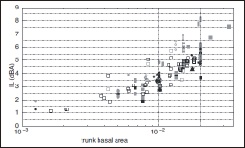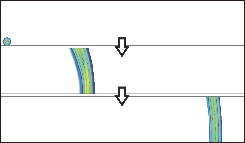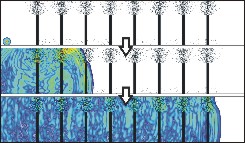Interactions between sound waves and tree belts
Road traffic noise shielding is mainly obtained as a combination of multiple scattering in the tree trunk layer and due to the presence of an acoustically soft soil (called forest floor, see (Appl. Acoust., 184, 108349, 2021). Although foliage is able to strongly interact with sound leading to scattering and absorption, these effects occur only at high sound frequencies that are not relevant in abating road traffic noise. That is why hedges (physically) reduce road traffic noise to a limited extent only (Appl. Acoust., 78, 19-27, 2014).
Multiple scattering in between the tree trunks will redirect acoustic energy away from the (direct) path between source and receiver, leading to effective noise reduction at a single receiver. Bark absorption can contribute to noise reduction as well due to the many interactions when sound travels through a tree belt, although the absorption coefficients are typically modest (Appl. Acoust. 165, 107328, 2020.).
Additivity of noise reducing actors
Full 3D numerical calculations showed that the trunk and soil effect can be treated independently (J. Sound Vib., 331, 2404-2425, 2012), allowing to reducing the propagation problem to modelling sound propagation in two orthogonal planes, largely reducing computational cost. Along roads, noise sources are positioned close to the ground, so tree height is not an influencing parameter once a certain height is reached (e.g. 2 m).
Planting schemes do matter
Simulations show that for the same amount of biomass per square meter, road traffic noise shielding can be strongly optimized by the planting scheme. The specific choice of a planting scheme, therefore, makes a tree belt along a road an efficient noise reducing measure or not (Ecol. Eng., 69, 276–286, 2014). Introducing some randomness was shown to be helpfull as well in further optimizing road traffic noise shielding.
Towards practical implementations
As a general rule, high biomass density (trunk basal area) should be strived for. This conflicts, however, with practical limitations regarding access to light, nutrients and water for the trees. Some interesting approaches have been identified to relax the need for high biomass density, without affecting noise shielding to an important extent (Ecol. Eng., 69, 276–286, 2014). Rectangular planting schemes, where the spacing orthogonal to the road can be increased, omitting full rows parallel to the road length axis, and thinning inside the belt are examples of such measures.
Exploiting supporting poles
In case of recently planted belts with juvenile and thus thin trunks, acoustical efficiencies are small. The presence of supporting poles was numerically shown to give a juvenile non-deep tree belt a reasonable noise abatement. Also here, the specific configurations of supporting poles in between the trees can further optimize its global shielding. Making such poles absorbing could strongly increase road traffic noise abatement of the tree belt (Act. Acust. Acust., 101, 1-7, 2016).
Figure 1
Scatter plot of road traffic noise insertion loss of a 15-m deep tree belt (relative to grassland) bordering a 4-lane road (15% heavy vehicles, 70 km/h). Each marker stands for a different planting scheme.

Figure 2
Visualisation of sound scattering by a tree belt (cross-section shown) by a FDTD simulation.
Reference situation

Tree belt
